IN-DEPTH
Bay Area policies and local approaches to combat the growing homelessness crisis in the Bay Area
PAGE 8-9
LIFESTYLE
Investigating similarities between tackle and flag football techniques
PAGE 13


Bay Area policies and local approaches to combat the growing homelessness crisis in the Bay Area
PAGE 8-9
Investigating similarities between tackle and flag football techniques
PAGE 13

Ezra Rosenberg Reporter
On Tuesday, Aug. 13, Governor Gavin Newsom sent a letter to school districts across California, including PAUSD, asking them to restrict students’ use of smartphones on campus.
This message was sent in response to the Phone-Free Schools Act, which — if signed by Newsom — would require school districts to implement a policy to limit or prohibit the use of smartphones at school by July 1, 2026. This act builds off of Assembly Bill 272, which was effective starting Jan. 1, 2020 and authorized districts to regulate cell phone use.
In the Superintendent’s Update on Aug. 23, Superintendent Dr. Don Austin addressed Newsom’s concerns by reinforcing PAUSD’s continued approach in allowing teachers to implement their own restrictions rather than administering a global uniform policy. However, he notes that further discussion regarding this issue will take place after a new school board has been elected in November.
“If we’re required by the state to ‘ban’ cell phones, then we’ll do it,” he said. “But, the state’s not going to do that because they understand the complexities (of the regulation) and the backlash they would receive. At some point we’re going to have the new school board weigh in on that.”
While PAUSD will not take any actions right now, the Los Angeles Unified School District — even prior to Newsom’s ordinance — set a precedent of implementing their own regulations. LAUSD voted in June to ban smartphone use for over 500,000 students during the school day starting in Jan. of 2025. In an LAUSD News Release, Los Angeles Unified Board President Jackie Goldberg explained how phones have impacted student behavior.
“Cell phone use in schools has gotten out of control,” she said. “It’s gotten to the point that students don’t talk face to face, but instead text one another when they’re sitting right next to each other.”
If we’re required by the state to ‘ban’ cell phones, then we’ll do it. But, the state’s not going to do that because they understand the complexities (of the regulation) and the backlash they would receive.
PAUSD has not decided on a universal policy like LAUSD, yet varying levels of phone restrictions have already been implemented throughout Gunn classrooms. According to a poll sent out to students, 33.3% of students have five to seven classes with cell phone restrictions.
Senior Dingyi Li shared her experience with the various classroom phone policies implemented throughout her classes on campus.
“Some teachers had no phone policy at all,” she said. “You could use your phone as long as you didn’t blast music. (But), some other teachers were stricter, (and used) phone pockets or (required students) to keep their phones in (their) backpacks.”
Although sophomore Isaiah Dai understands the downsides of permitting cell phone usage on campus, he does not believe that confiscation would be the best practice.
“Phones shouldn’t be banned completely, but I think you shouldn’t use them that much in class,” he said. “I am a lot more efficient when I don’t use (them). But, you definitely (should) have it at school and you should keep them on yourselves, but just don’t use them.”
Computer science teacher Joshua Paley uses phone pockets in his classes to combat distractions. If a student uses their phone during class, he confiscates it for the rest of the day.
“When a teacher writes a lesson, they are trying to figure out how to help the student learn,” he said. “Teachers don’t want students to have distractions, (but) they are stuck with (it) because of cell phones.”
Principal Dr. Wendy Stratton suggested a potential method to ease students into a universal policy regarding phone restrictions.
“(We could try) to pilot something school-wide,” she said. “I think the most important thing will be to create something so that people have
a moment of understanding around (the situation).”
Learning from his previous experiences, Assistant Principal Dr. Mycal Hixon emphasized the essential role student voices played in implementing such policies.
“I came to the school district from a high school (that) implemented something similar,” he said. “(They) didn’t involve student voices or agency, so it didn’t turn out great.”
To work with students, staff and parents in creating a suitable policy for the district community, Stratton assembled the Gunn Cell Phone Policy Review and Revamp Ad Hoc Committee.
“The ad hoc (committee) will engage in a structured problemsolving process that addresses mindsets, defines the problem, establishes solution criteria, brainstorms solutions and selects solutions to implement here at Gunn,” she wrote in a Schoology Update.
The first meeting took place at lunch on Wednesday, Sept. 11. Members of the meeting discussed strengths, weaknesses, opportunities and threats regarding the uses of cell phones. Junior Claudia Wolff De Tourreil, who was a member of this meeting, believes that cell phones negatively impact student education.
“I think that cell phones have definitely gotten in the way of a lot of the learning that we try to do in class,” she said. “Often, around campus, I see lots of people sitting around on their phones and not engaging with each other.”
Wolff De Tourreil found the meeting to be significant in addressing cell phone issues and allowing for student voices to be heard.
“We started to think about how cell phones are impacting our school,” she said. “I think there’s definitely a lot more to do and talk about, but I think (the first meeting) was a good start.”
Despite this student outreach effort, PAUSD has no plans to implement phone restrictions or a phone ban at the moment. Teachers still have control over establishing the phone policies in their classrooms and students can participate in discussions regarding phone regulations.
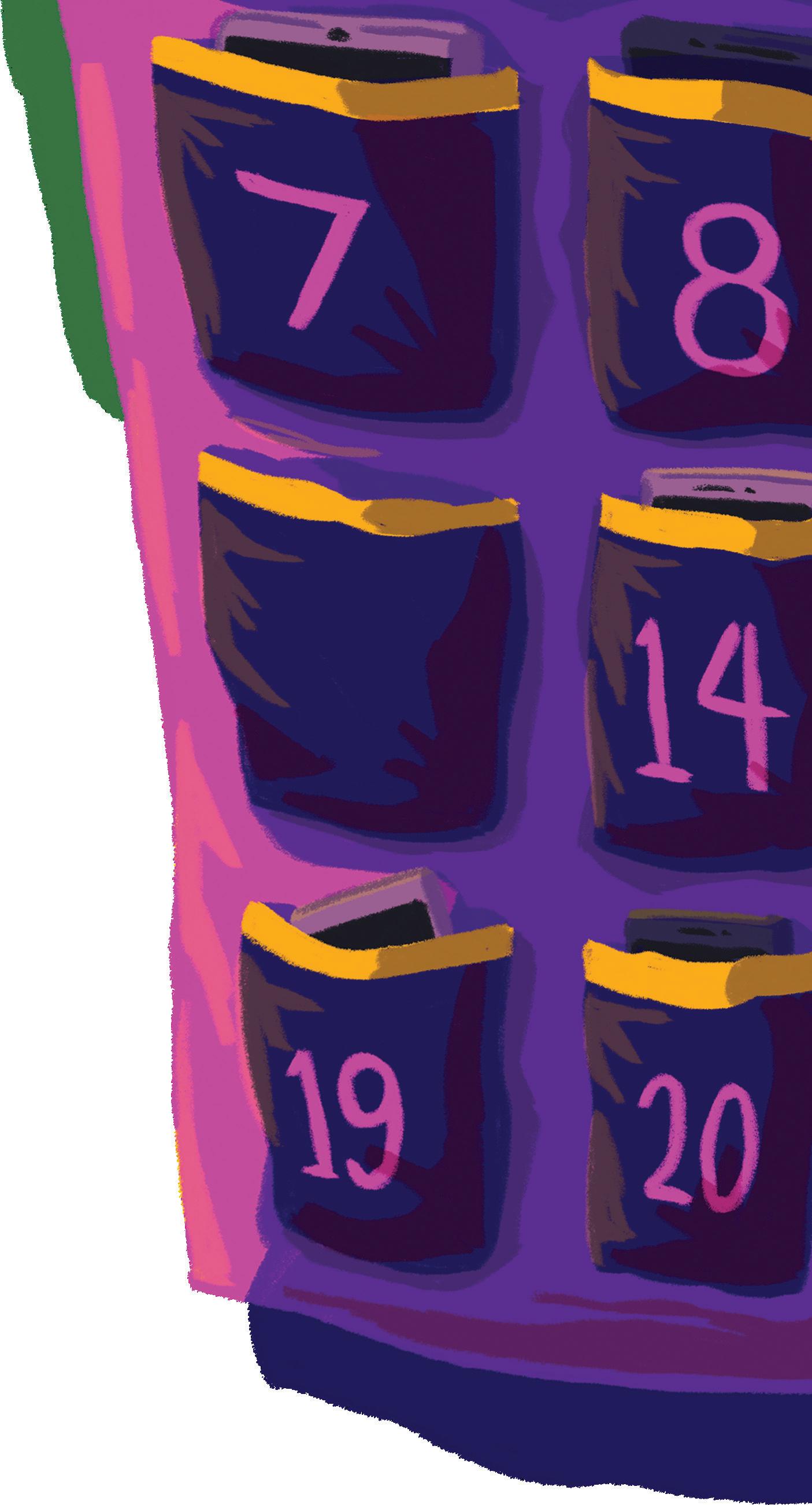
disagreestudents with gov. gavin newsom’s proposal
“I think people are looking for a measured response, because this should not become a third rail issue,” Austin said. “What (the solution is) won’t be determined by a governor’s press conference and some advocacy around this topic. It’ll be much more thoughtful.”




by
Roy Lao and Ya-An Xue News Editor and Features Editor
The California Department of Transportation began construction in northern Palo Alto on Sept. 3 as a part of the El Camino Real Repavement Rehabilitation and American Disability Act Improvements project, which is anticipated to be completed in the fall of 2025. The construction will begin at Sand Hill Road and continue southbound to State Route-237 in Mountain View.
Construction will occur on both sides of the road, impacting the use of bike lanes. To help minimize traffic delays, the majority of the work is being completed overnight rather than during commute hours. Since Sept. 9, signs have been posted to prevent vehicles from parking along the road until the area is clear of construction.
This project falls under Caltrans’ Capital Preventative Maintenance project, which calls for the annual improvement of state roads and includes filling potholes and re-laying concrete. According to Caltrans, the estimated budget of the El Camino Paving Project is $44.6 million, an amount which comes from the State Highway Operation and Protection Program and local funds. In compliance with the ADA, curb ramps and crosswalks will be improved to meet current accessibility requirements.
According to University of California Berkeley’s Transportation Injury Mapping System, in the past ten years there have been a total of 3,179 recorded traffic accidents in Palo Alto, resulting in 23 fatalities and 4,125 injuries, with bicycles being involved in 18.6% of accidents. In 2020, in response to these numbers, Caltrans began submitting documents for repavement. However, according to Palo Alto Planning and Transportation Commissioner George Lu, the construction was delayed.
“(Caltrans) is overdue to repave El Camino,” he said. “They started a process two or three years ago to repave the streets. The motivation from the state was that El Camino has a couple of intersections and sections identified as high safety risks where there has been a history of accidents.”
The project also includes the implementation of Class IV bike lanes with vertical buffers separating bikes from traffic lanes and Class II bike lanes that consist of only painted striping. These additions, which are expected to cost $3.2 million according to the state agency, will allow bikers to travel on the road instead of on sidewalks with pedestrians. Cars will also be prohibited from turning right during red lights as an additional preventative measure.
Despite these precautions set in place, Gunn Bike Club advisor Karen Saxena, an avid biker who appreciates the city’s bike accessibility and existing infrastructure, noted her preference for the neighborhood bike paths that are not on El Camino.
“I’m not sure I feel that a bike lane on El Camino will be a safe place to bike — there are too many entrance and exit spots that are unlikely to make it safe,” she wrote in an email interview. “There are so many other options, so I will probably continue to use (them instead).”
Additionally, the project decreased the amount of parking space available along El Camino Real. A City Council staff report stated that around 41 residents living on El Camino in recreational vehicles were displaced. Deputy City Manager of Palo Alto Chantel Cotton Gaines explained that the Palo Alto Community Foundation, with the council’s support, successfully filed for a grant to expand an existing parking site on Geng Road from 12 to 22 parking spaces. This expansion requires a significant investment from the city, who will support the operation by withdrawing from their midyear budget this December. The site is currently operated by the nonprofit Move Mountain View, which includes a children’s library and other programs.
“The motivation from the state was that El Camino has a couple of intersections and sections identified as high safety risks where there has been a history of accidents.”
Palo Alto Planning and Transportation Commissioner George Lu
“They are really trying to help people get established as they make their way towards permanent housing,” Gaines said. “The City Council realized this opportunity for us to expand that lot so that we can accommodate some of the relocating RVs because there is always a waitlist for our Geng Road site.”
While the Geng Road parking site is undergoing preparation, the city has partnered with Santa Clara County and various organizations to support RV families. Their programs will remain important even after the new site opens, due to the limited capacity and long waitlist.
“We are regularly (in) contact with families along El Camino, and there are two nonprofits that offer things like health assistance and vehicle services,” Gaines said.
“We want to make sure that people living on the street, in regular vehicles (and) RVs, know that they can take advantage of the congregation-based parking sites in the city and other possible services that could be available countywide.”
In the project preparation stage, City Council members Ed Lauing and Pat Burt reviewed plans and discussed changes with Caltrans. While the project falls under state jurisdiction, Caltrans was responsive to the city’s input.
During the City Council meeting on May 1, Caltrans pushed for a bike lane. However, council members called for the state agency to revise their plan, backed by a council-funded study by Fehr & Peer that cited concerns regarding bike safety and parking regulations. On June 27, after reviewing an updated design, the council approved the bike lane plan that is currently in effect.
“While the state is proposing safety improvements, for some people, just by building bike lanes on a pretty unsafe road, you would create more risk overall,” Lu said. “I had a bunch of recommendations for really specific intersections, and I was like, ‘Oh, they actually work through the City Council, work through the staff and get some of these suggestions implemented.’”
Listening to concerns from residents, the council also considered the impact of the displaced RVs moving into neighborhood parking. Additionally, council members noted the possibility of vehicles parking near small businesses, which would reduce the amount of parking for customers. In response, when approving the final plan, the City Council also approved changes to the Residential Preferential Parking, which will grant certain businesses employee parking in roads adjacent to El Camino.
However, according to Lu, around 80% of businesses in the area have their own parking lots, so this concern is not a major issue.
“I think that issue was always a little bit overblown,” he said. “You might not always know (parking lots) are there because (small businesses) have not needed to advertise them, but there are a lot of parking lots, and most of the businesses will be okay.”
While construction will affect school bike routes and traffic flow, Lu highlighted its necessity and benefits, especially in Palo Alto where there are so many resident bikers.
“There’s definitely the possibility of needing to detour,” Lu said. “I think the construction will be honestly quite disruptive, but I think the outcomes will be worth it.”
780 Arastradero Rd.
Palo Alto, CA 94306
(650) 354-8238
www.gunnoracle.com
Editorial Board
Editor-in-Chief
Kaylee Cheng
Ma naging Editors
Anne Dong
Charlotte Qian
News
Roy Lao
Sylvie Nguyen
Forum
Gwen Domine
Yu-Ming Liu
Features
Claire Jittipun
Vanisha Vig
Ya-An Xue
In-Depth
Eanam Maor
Lifestyle
Yael Gottesman
Violet Tivol
Online
Vanisha Vig
Ya-An Xue
Photo Editor
Naomi Wang
Graphics Editor
Sarah Xie
Staff
Business/Circulation
Sylvie Nguyen
Oracle/SEC Liaison
Gwen Domine
Graphics Artists
Vin Bhat
Elise Hu
Sophie Kou
Jessie Li
Jennifer Li
Rin Sanami
Photographers
Evelyn Chow
Nicole Mok
Chloe Wu
Reporters
Ezra Rosenberg
Vaani Saxena
Adviser
Kristy Blackburn
Inbox Submissions
The Oracle strongly encourages and publishes signed Letters to the Editor and Comments. Comments are generally shorter responses, while Letters are longer pieces of writing.
Please include your name, grade and contact information should you choose to write one.
Letters and Comments may be edited to meet space requirements, and the writer is solely responsible for the accuracy of the content.
Letters to the Editor, Comments and ideas for coverage may be sent to oraclegunn@gmail.com. These letters do not need to be from current students.
Yu-Ming Liu Forum Editor
Palo Alto Middle College, the third high school in PAUSD, welcomed its inaugural class of sophomores and juniors to building 6300 on the Foothill College campus in August.
The school was opened for students seeking an alternative to the traditional high school learning style. Before its establishment, the program was offered through the Mountain View-Los Altos School District. According to Assistant Principal Harvey Newland, it was essential for PAUSD to establish its own Middle College program alongside MVLA’s.
“Taking ownership over (our own Middle College) as a district is huge, because we were relying on a different district,” he said.
The enrichment opportunities provided at Middle College High School, such as community college courses, allow students to learn in an environment they can see themselves thriving in, according to Newland.
“I look at (it as) some type of alternative for students,” he said. “They might fit differently in a scenario such as Middle College, where you’re able to take college courses. It’s just one of those things that we use as a district to differentiate student learning.”
Middle College students are also able to join the Transfer Admissions Guarantee program after graduation, where applicants are guaranteed acceptance into six University of California schools and have higher acceptance rates for more selective institutions. For Middle College junior Liam Wong, the benefits of being in the TAG program was a motivator for him to apply.
“If you complete (the TAG application process), you can graduate two years early or be a dual major,” he said. “At Gunn, everyone has a 4.0 average (GPA), so I felt like, at Middle College, you could differentiate yourself.”
According to Wong, a specific class called counseling helps prepare students for college and above.
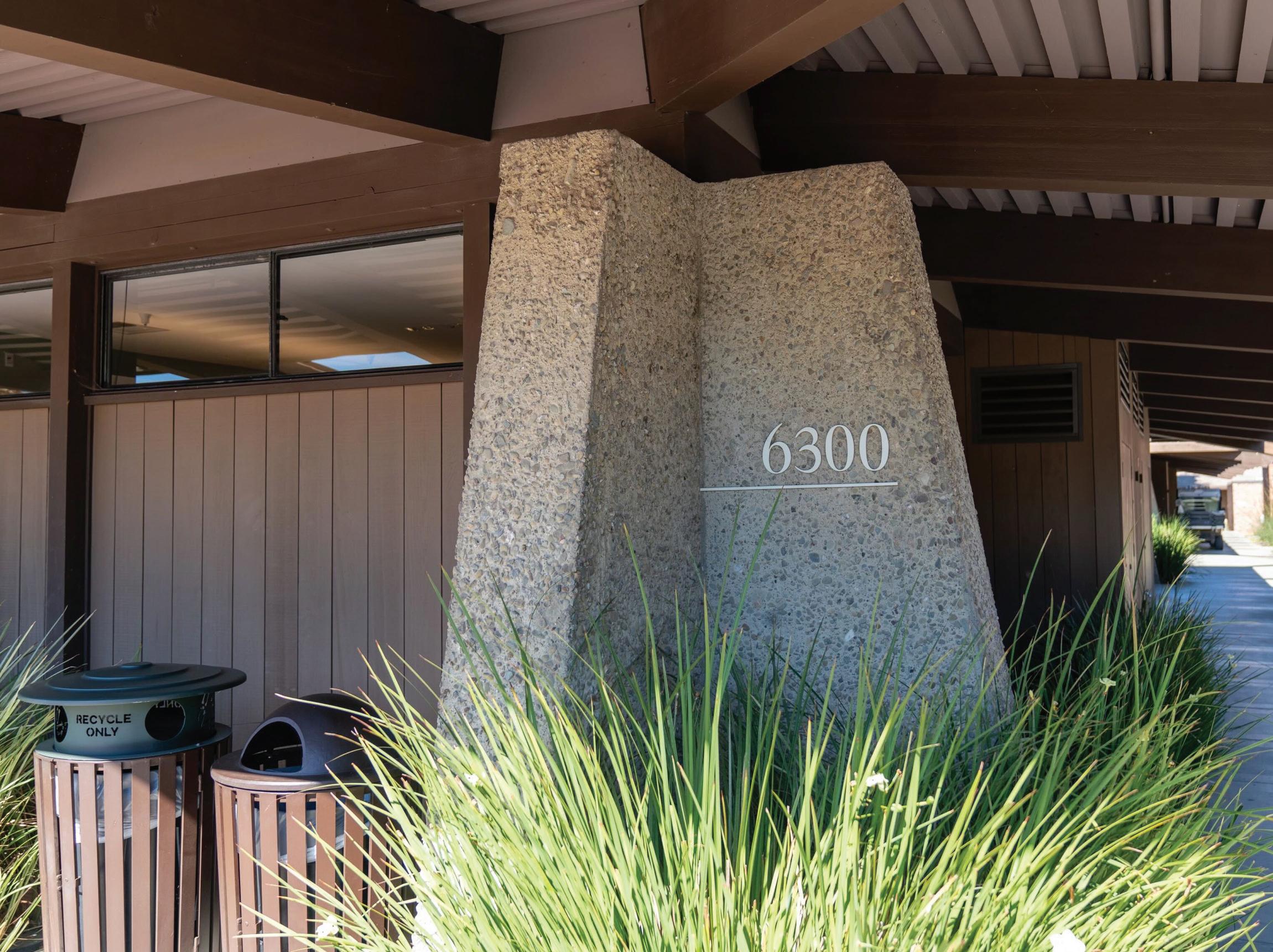
“It is a course where you get ready for (university and acquire) different learning habits,” he said. “It tells you the different ways you could go from (Middle College), like associate, business and bachelor degrees.”
Additionally, Middle College grants students more flexibility with their schedules. According to Wong, students can decide whether to take their college or high school classes in the morning or afternoon.
“For the first five weeks, you don’t have to show up (to school) until 10 a.m. if you take college courses in the morning and your high school courses in the afternoon,” he said.
Composed of around 120 students who attended either Gunn and Paly in the previous school year, students learn on the Foothill College campus full-time. They are able to
50.8%
take two college classes — which earn them college credits — and three high school classes, according to Principal Dr. Wendy Stratton.
In the 2023-24 school year, only freshmen and sophomores in PAUSD were eligible to apply to Middle College. According to Wong, Middle College typically admitted students who may not fit in a normal school setting, which was a factor assisting in the creation of a small class size and tightly bonded community.
“Since (Middle College) is such a small community, you’ll get to know your teachers, the staff and even the front desk lady, since you will see them every day,” he said. “It feels like a big family, and you get to know your teachers a bit more since there’s a lot more one-on-one time.”
3.6%

Dear Titans,
I am beyond proud to present the first Oracle issue of the year — we know you’ve missed us, and it feels so good to be back.
These pages, including all upcoming issues, aim to equip you with everything from campus news, student opinion, features on peers and investigations on student-related policies and legislation to light-hearted humor pieces and crossword games.
The Oracle staff works diligently, through my endless nagging, to bring you our very best work every month. Even though our staff has decreased in size from previous years, I want to emphasize my deep appreciation for every staffer’s dedication and selflessness in achieving our cause, which will always be to provide the Gunn community with timely and accurate news and working to champion the underrepresented voices on campus.
With that being said, there are some things that are going to change this year, such as a new 16-page full color format and the amalgamation of the previous section Centerfold into In-Depth and Sports into Lifestyle.
However, some things, like our belief that student opinion is the cornerstone of this publication, have not changed. We encourage all
of you to be an advocate for the change and progress you would like to see. We love hearing your opinions on everything from student polls to issue feedback and story ideas — so make sure to follow us on Instagram (@gunnoracle) and use the links in our bio to contribute to next month’s issue!
Now more than ever, we are looking for you to join us. Being on staff will instill within you, like it did me, a sense of purpose and belonging on campus. From boba runs on Wednesday afternoons, winter gift exchanges, chaotic games of “Heads Up!” late into the night to off-putting icebreaker questions during production dinners, we pride ourselves on the fact that we consider our staff a family. If this sounds like something you are interested in, don’t hesitate to reach out to me for questions, become a freelance graphics artist or photographer or sign up for Beginning Journalism starting your sophomore year.
Ultimately, the core of our journalistic mission — to quote poet Cesar A. Cruz — is to “comfort the disturbed and disturb the comfortable.” The Oracle strives to cultivate thought-provoking conversation, challenge assumptions and spark meaningful change in our local community. We ask for your respect in the work that we do and invite you to give us the chance to make a lasting impact on your life.

Eanam Maor In-Depth Editor
Voting in national, local and school board elections is one of the most representative and democratic practices in the United States — it allows for people to be directly involved and informed within their community and make a significant impact. As the most prominent democratic practice available to U.S. citizens, voting is a valuable way to gain experience in politics and civics, improving voters’ critical thinking.
Being able to participate in school board elections will help students be more informed as adults, and this important opportunity should not be taken from them simply due their age. A person’s first voting experiences are what shape their mindsets when engaging in civics in the future, and in most cases, teenagers have the least amount of financial responsibilities, allowing them to dedicate more effort and thought into their votes. Being able to take the time to educate themselves and figure out the voting process when they have fewer responsibilities will improve their ability to begin their voting experience positively.
Voting within local, school board and national elections is one of the most representative and democratic practices within the United States.
Additionally, teenagers are affected by many legislatures, especially in school board and local elections, and should be able to contribute to the decision processes of enacting them. In recent years, protests — another democratic practice — have been frequent. While the idea of students using their voices and taking action to enforce necessary changes is a positive thing, protests and other types of civil resistance, which have the potential to be disruptive and result in police intervention, shouldn’t be the first experience in
engagement for young people wanting to make an impact.
Some opponents argue that students are too inexperienced and immature to vote properly, as they may only look to what benefits themselves instead of the community as a whole. However, they ignore that teens generally have access to resources in school to learn how to effectively inform themself and go through the voting process constructively — therefore, they gain the experience necessary to vote and are capable of filling out a ballot.
Instead of only being able to contribute their opinions after legislation, high school ers should have the ability to directly make an impact on local issues. This way, not only will they learn the techniques of voting early and continue to improve as an adult voter, but they will see the impact they are making on their community. When these students know that their voices are able to contribute to the better ment of their communities, they will gain confidence in their ability to par ticipate in civics, a key part of successful democracies.
Source: Self-selected survey sent outtoGunnstudentsbyTheOracleresponses.fromAug.30toSept.13with190
91%STUDENTSOFSURVEYED haVE cONFiDENcEiNThEiR aabiliTiESTOVOTE TSchOOlbOaRD ElEcTiONS

84.8% OF SURVEYED STUDENTS wOUlD VOTE aT SchOOl bOaRD ElEcTiONS iF giVEN ThE OppORTUNiTY TO VOTE
Source: Self-selected survey sent out to Gunn students by The Oracle from Aug. 30 to Sept. 13 with 191 responses.
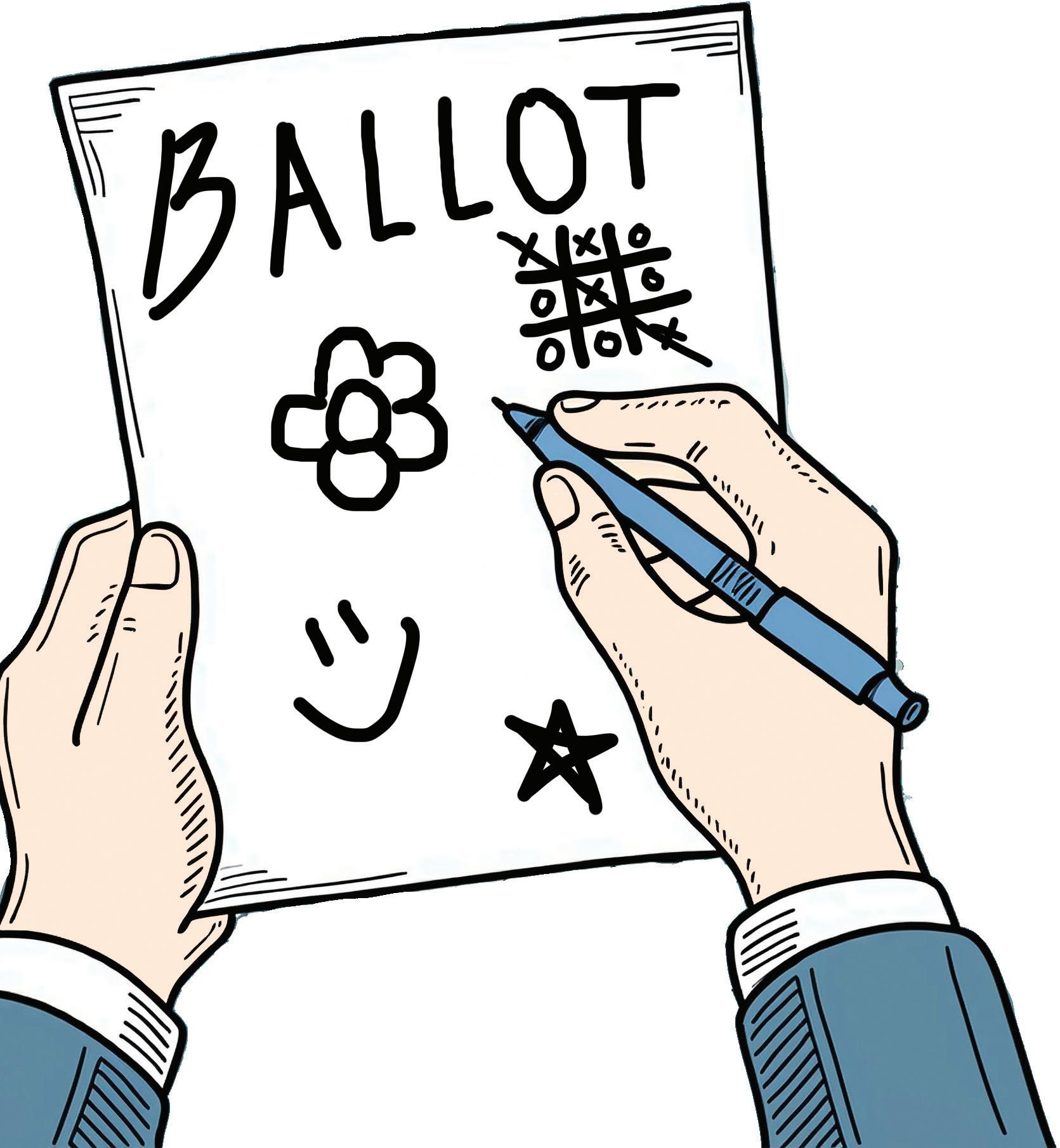

Yael Gottesman Lifestyle Editor
The PAUSD school board, made up of five elected members serving four-year terms, has three main responsibilities: Policy-making, administration and judicial duties. They set policies to guide the superintendent and staff, develop a long-term vision for the district, approve and monitor the budget and oversee hiring and evaluations. The board also handles opinions from staff, students and parents, which requires confidentiality and a strong understanding of school laws and regulations. Therefore, in order to elect officials that can fulfill these duties, it’s important that voters are educated and not easily influenced by others’ opinions.
In general, students and teenagers don’t fully understand the importance of a well-balanced school board. Although they do experience the education system firsthand, students often only focus on what benefits them directly instead of what benefits the community in the long-term.
On the other hand, the staff work together to run the school. This means that they understand the decisions that need to be made and foundations that the school is built on. Also, teachers have a stronger understanding of what changes the school requires
with their experience under the school board’s policies. The involvement in a multitude of activities throughout the school system also gives them a valuable understanding of education. This outlook provides staff with the ability to make well-informed votes. In addition, parents are more likely to vote for the greater good, as throughout their lives, they garner knowledge on what they want to see in their childrens’ education system. This provides them with a broader understanding of long-term priorities, financial management structure and the goals of the school.
Although they do experience the education system first-hand, students often only focus on what benefits them directly instead of what benefits the community in the long-term.
Additionally, students have a tendency to give into peer-pressure. High school is a time when students are figuring out who they are, which can cause them to be pressured to conform to certain ideas and societal standards. This pressure could extend into their voting decisions for the school board, as the influence of friends may lead students to prioritize popularity and validation from others over informed, independent choices.
The PAUSD school board is extremely important, as it affects the lives of students, parents, staff and community members. It requires candidates who are well-suited for the position and voters who are informed enough to vote for them. Students lack the necessary experience to make these decisions and can be more easily influenced by their friends, which does not allow them to cast votes that align with their personal values and prioritize the greater good.

With the United States presidential election drawing closer, political conversations are becoming much more difficult to avoid on campus. Growing up, students have been told to stay away from the discussion of politics in the classroom, and that teachers were barred from broaching the subject in order to not indoctrinate students to political beliefs. However, as more political topics become relevant to curricula and students get closer to graduating into the real world, conversations once deemed taboo are both inevitable and beneficial in equipping students with the necessary tools to thrive after high school.
Politics add relevance and engagement to classroom discussions. This applies to all the social studies classes, as well as in English and many other subjects which touch on the subject of politics. In the Contemporary World History course, lessons around the Cold War or the Middle East still hold relevance if they are contextualized in the political trends of today. When English classes read “To Kill a Mockingbird,” conversations about discrimination allow further analysis of character and setting. In classes such as the new ethnic studies course, which has a curriculum rooted in current events and local history, preventing political discussion would only be a hindrance to education.
Furthermore, as more issues become politicized, trying to avoid the topics in class causes more harm than good. What is allowed to be taught in classrooms is an issue of political contention, as some current political initiatives are centered around censoring education. At Gunn, biology classes teach evolution, English classes read books that are on banned books lists, history classes teach about historical systemic injustices and economics classes analyze specific strategies that are relevant to opposing campaigns. Some of these lessons have been banned in other school districts around the country, and to teach them in itself is perceived as a political opinion by the school. However, it is important to realize that ignoring these topics eliminates the possibility of students expanding their horizons by learning more about topics concerning policies. This will inevitably lead to a lack of political knowledge in students, and as they become adults, they will become less informed — maybe even misinformed — about civics and current affairs.
While there may be more reasons to limit political discussions in elementary or middle school, due to many topics being too mature for younger children, by high school, students are ready for complex subject matter and conversation. High school students are ready to respectfully debate and appreciate the nuance and realworld connections essential for political discussions. Creating more space to have these conversations better equips students for future civic engagement and political awareness, which is especially important considering the current low young voter turnout in elections. According
to the Center for Information and Research on Civic Learning and Engagement at Tufts University, younger voters only had a turnout rate of 23% during the 2022 election season. If students learn about current political stances and elections through an objective, educational lens in school, they will be better prepared and feel more empowered to stay educated on the issues and be committed voters as adults. While these topics are touched on in U.S. government courses, interweaving these conversations into different classroom settings can teach students the association of political issues with other subjects they are interested in. Teachers moderating these discussions can also prevent students from receiving their information from a different, more biased medium such as social media. Overall, teacherled deliberation over these topics can reduce the political polarization that students can encounter in today’s world of media.
In classes such as the new ethnic studies course, which has a curriculum rooted in current events and local history, preventing political discussion would only be a hindrance to education.
Political discussion can also prepare students for difficult conversations in areas that are commonly described as predominantly unilateral in its political identity. Therefore by creating a space in classrooms for political colloquy, students will be exposed to opinions they weren’t expecting to hear or nuances in perspectives that would not have come up in casual conversation. Learning how to have respectful and thought-provoking conversations about subjects that can be controversial is an important academic and social skill which students can carry with them throughout their lives.
Many often argue that political discussions should stay outside of the classroom in order to maintain professional student-teacher relationships without involving the political opinions of each person. They contend that students are at school to learn and teachers should relay that information in a proper manner, as they are often afraid that students will be indoctrinated and influenced by their teachers’ opinions. However, this does not apply to politics in the classroom because teachers would be there to facilitate proper discussion. These conversations should be encouraged in relation to relevant course material or current events, creating a safe space for civil discourse and questioning.
With proper facilitation, students can be empowered to stand up for what they believe in and feel supported by the school community in their continued curiosity of political issues. The first step to beginning their own journey in civics is learning this material in an objective, moderated environment that schools should provide for their students.


For centuries, societies have relied on the spoken word to spread information, often in hopes of furthering initiatives, whether for political campaigns or social reform. It has not only proven to be effective in delivering information, but is also extremely important in building community networks. Therefore, students on campus will inevitably participate in discussing information, whether scientific, political or social. As someone who actively engages in such mechanisms of discussion, I have begun to notice an increasing amount of inaccurate information circulating on campus. While the spread of misinformation in our community is often unintentional, it is worth considering alternate ways of minimizing such confusion. Thus, to help promote the distribution of more accurate information, students should try to be more mindful of what information they are delivering and how they are presenting it, as their tone of voices can falsely imply “fact” when they really mean “opinion.”
On campus, students tend to hear information and parrot it back, repeating an interesting fact or surprising figure to another person. Yet, in this word-of-mouth system of passing along information, some key details get lost. Perhaps the most crucial component in analyzing why this phenomenon happens can be illustrated from a ubiquitous game we all played in elementary school: Telephone. What started out as “unicorns tend to be related to pink cotton candy” might eventually end up as “unicorns cause cotton candy to turn pink” because we simply cannot remember every exact detail. Then, we simply say something that “feels about right.”
A common marketing strategy in business is relying heavily on daily, spoken interactions to build brand image. However, while this method is effective in building brand awareness, this concept should not be applied to politics, science, academia or any other data that relies on accuracy and precision. Likewise, the pitch and tones of the presenter’s voice can also influence the way the listener perceives the information. In fact, an article on Forbes showed that 62% of people tend to respond more quickly to information presented in a positive way and accept it as true. While it may seem obvious that a positive tone makes the information introduced sound constructive and factually correct, it plays a deeper role in what we internalize as correct. In an article published by the International Journal of Environmental Research and Public Health, the study claims that social presence — a theory that argues that people process information differently based on the format it is presented in, especially the change in psychological perception when other people are present — played a major role in the spread of information on COVID-19 in 2020. This research effectively demonstrates how people can perceive information differently when they receive it verbally versus reading it from an article or on social media. On campus, I have noticed a pattern of students voicing their opinions as if they were facts — I certainly have been guilty of making this fallacy as well. Additionally, students may also occasionally exaggerate the truth to entertain the listener, further perpetuating this chain of inaccuracy and misinformation. As a result, people may mistakenly confuse their peers’ opinions for what is factually correct and pass that information to the next person.
The last thing I want to do is to blame people for spreading inaccurate information — it’s not really anyone’s fault and we certainly should not be pointing fingers. Instead, I encourage people to conduct a quick temperature check every so often: “Is what I’m saying my opinion or a fact?” and present the information accordingly. Selfawareness is, in my opinion, the best way to create positive change, and we can do that together one sentence at a time.

Gwen Domine Forum Editor
The phrases “I’m just a girl,” “girl math” and “girl dinner” are a commonplace throughout social media platforms such as TikTok and Instagram, with posts garnering millions of likes, shares and comments. In fact, National Public Radio credits 2023 as the “Year of the Girl” due to the inordinate amount of “girl culture” content on social media platforms. These phrases, while humorous and seemingly innocuous on the surface, wield an unintentional effect of contributing to stereotypes and the undermining and infantilization of women.
These phrases, while humorous and seemingly innocuous on the surface, wield an unintentional effect of contributing to stereotypes and the undermining and infantilization of women.
One example of this phenomenon is the widespread use of “girl math.” Originally created as a humorous way of justifying excessive and irresponsible spending habits, it continues to perpetuate ideas that women are less financially responsible, less fiscally independent and less self-sufficient — qualities that paint women as clueless, overly codependent, and ultimately stunting their motivation for the acquisition of financial knowledge. According to a 2022 Teachers’ Insurance and Annuity Association of America Institute survey on financial literacy, women answered an average of 45% of questions correctly, compared to the 55% correct answer rate by
condescending manner. According to a 2015 Pennsylvania State University study contrasting the use of “girls” versus “women,” the group referred to as “girls” felt significantly less self-assured, believing that they had a lack of influential qualities and that others would not take them as seriously or respect their authority. Phrases like “I’m just a girl” encourage behaviors that contribute to these problems, as videos with these themes often feature a woman blaming her mistakes or lack of knowledge in a subject on her gender. This phrase embodies the stereotypes of incapability and frivolity that have been pushed upon women for generations — stereotypes that threaten to resurface when society perpetuates trends like these.
Yet another phrase, “girl dinner,” has become more common after content creator Olivia Maher posted a video showing a charcuterie board, referring to it as her dinner. Since then, the trend has evolved to depict “girl dinners” as mainly low-effort and low-nutrition snackstyle meals. The “girl dinner” trend is destructive on another level – it has the potential to lead to unhealthy eating habits, especially in impressionable teens on social media. According to a 2018 study by healthcare provider company Providence, 93% of individuals between the ages of 14 and 22 use social media. Consumers of social media often view influencers as role models, causing them to imitate unideal lifestyles. Teens often follow these content creators to an unhealthy extent, especially with trends such as “girl dinner” that can promote and normalize a diet lacking the nutrition and calories necessary for adolescents to fuel their bodies and minds.
Although these trends have the ability to cause destruction, some may argue that they highlight the joyful, lighthearted side of girlhood. They believe that these trends allow women to reclaim the hate that has been brought against them, serving as a healthy form of escapism for women who missed out on their childhoods. However, while the trend originated as a fun way to joke around with stereotypes, it has been taken too far. The
embedded sarcasm that completes the story — instead, they see a depreciated version of the roles women play in today’s society. This especially affects the younger generation, one that draws many examples from the influencers they see on social media into their daily lives, a reality which can result in the bolstering of these harmful trends.
While there are many detrimental stereotypes and harmful rhetoric against women, this specific phenomenon is worth scrutinizing because it is mainly internally perpetrated and maintained by women. Movements such as “girls supporting girls” and #MeToo created a shared community for women to help each other, confide in each other and share advice. However, trends pertaining to girlhood undo the progress achieved by its predecessors.
While there are many detrimental stereotypes and rhetoric against women, this specific phenomenon is worth scrutinizing because it is mainly internally perpetrated and maintained by women.
Harmless on the outside but deeply calamitous under examination, the girlhood trends lead to the infantilization of women, the perpetration of stereotypes and unhealthy habits. Simple TikToks and Instagram posts lay a heavy hand on society, especially in teenagers and adolescents, due to modern reliance on these platforms as legitimate sources of information. Influencers, who often don’t understand the negative effect that these trends have on women, feminism and our economy, are the ones who keep trends alive. Content creators and their followers unknowingly participate in the perpetuation of stereotypes that shape our society. Because of ignorance like this, teens are left on their own to navigate the chokehold of social media and the vise that girlhood trends have ing mindfulness before ticipating in potentially damaging trends can its and empowerment rather than harm and

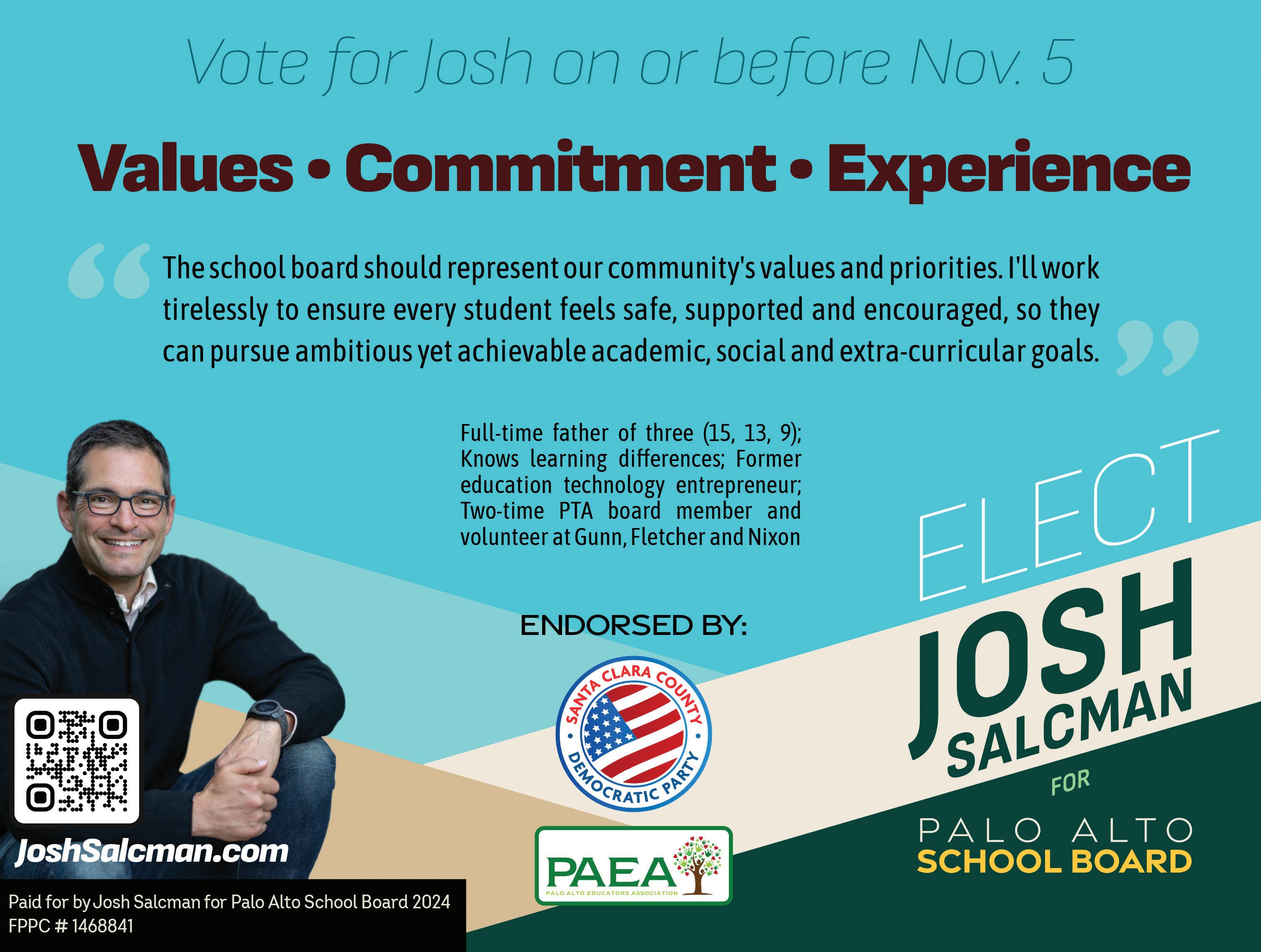
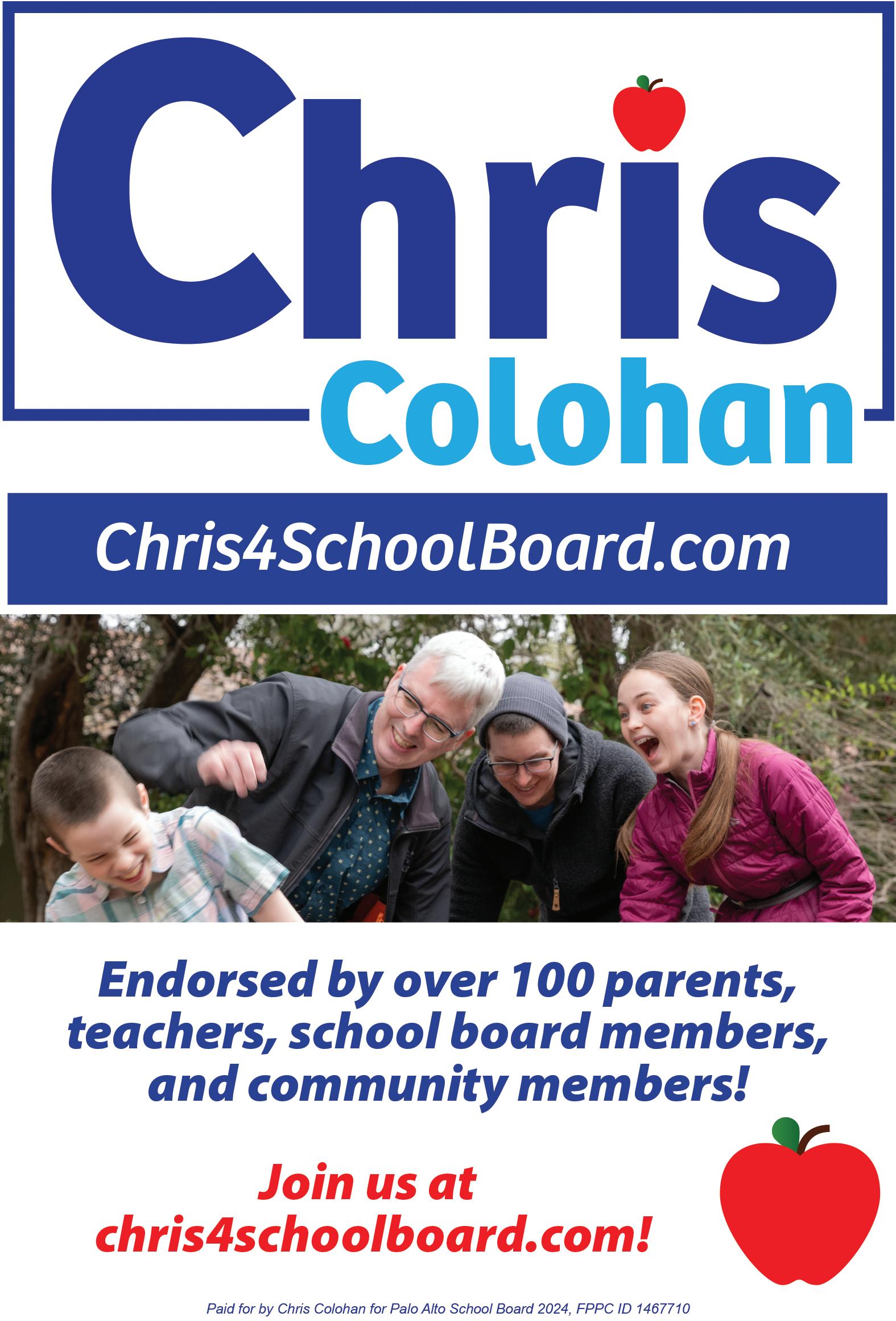

Sylvie Nguyen News Editor
After an intensified state-wide political crackdown on homelessness following recent court rulings, the Bay Area is caught in an imbalanced pendulum of transitioning the homeless to stable shelters and long-term dignity-based solutions for unhoused families.
The urgency of the issue is underscored by the United States Supreme Court’s ruling on June 28 that granted cities the authority to ban people from “camping” on public property and the right to clear encampments — even when there is no shelter available. Nearly a month after the ruling, California Governor Gavin Newsom mandated state agencies and local governments to adopt policies that would sweep away encampments on state property in an executive order.
In Palo Alto’s political maneuver to make tangible improvements for the unhoused while also complying with state mandates, the issue remains complex. Immediate relief for the unhoused requires urgent action for our community’s well-being. However, the root causes of the problem call for systemic changes and innovative treatment at the national and state levels.
The U.S. Supreme Court ruling stems from a 2018 lawsuit, Grants Pass, OR v. Johnson, Gloria, et al. This case involved the Camping Ordinance in Boise, Idaho, which made camping and sleeping in public or private places without permission a criminal offense. The Ninth Circuit, a federal appeals court, ruled against Idaho, citing that the ordinance violated the Eighth Amendment’s protection against criminalizing unsheltered individuals. Ultimately, Boise was prevented from wrongly assuming that these people were voluntarily homeless and had a choice in their circumstances. This year, in a decision with six in favor and three dissenting, the supreme court declared that Grant’s Pass laws were not unconstitutional.
The court’s rationale was that being homeless inevitably leads to sleeping in public spaces. This effectively removed long-standing legal constraints on cities. Now, cities could arrest and fine unsheltered individuals. The court’s syllabus defines that the local government may criminalize people who are homeless for “sleeping outside with as little as a blanket” because “there is no . . . separation between being without indoor shelter and sleeping in public — they are opposite sides of the same coin.”
Sleep is a biological necessity, not a crime. For people with no access to shelter, (this ruling) punishes them for being homeless. That is unconscionable and unconstitutional.”
-Justice Sonya Sotomayor
From another perspective, the ruling of Grants Pass crushed the humanization of the unhoused and would further intensify the growing homelessness crisis, as noted by Supreme Court Justice Sonya Sotomayor.
“Sleep is a biological necessity, not a crime,” she wrote in her dissent. “For people with no access to shelter, (this ruling) punishes them for

being homeless. That is unconscionable and unconstitutional.”
Governor Gavin Newsom’s executive order in July, issued following the Supreme Court ruling, emphasized local goverment’s responsibilities in combating the homelessness crisis.
“We (now) have no excuse with the Supreme Court decision,” he said in a video statement on X. “This executive order is about pushing that paradigm further and getting the sense of urgency that’s required of local governments to do their job.”
Homelessness in California exacerbates the national issue with 9,903 people experiencing homelessness in Santa Clara County, according to the 2023 Point-in-Time Count. Having 180,000 homeless individuals, the Golden State had more than one-quarter of the nation’s total, per the New York Times.
There are three subpopulations of people experiencing homelessness in California: 80% are adults without children, 14% are families with children and 7% are unaccompanied youth ages 24 and younger, according to the California Budget and Policy Center.
However, California senior policy analysts Monica Davalos and Sara Kimberlin, state in their article, “Sustain Diverse Housing Interventions Is Needed to End Homelessness,” that different interventions are needed to ensure that individuals experiencing temporary or chronic homelessness secure and maintain housing.
Homelessness at any age causes trauma, whether it is physical, mental or economic. The conditions have
When she was 4 years old, WeHOPE Senior Manager Lynelle Bisley was tagging along with her mother to help out in homeless shelters around her area. By the time she reached her teens, various grassroot initiatives such as Primrose and Samaritan House inspired her to participate and contribute to the cause. After completing her education, she immediately became a full-time volunteer coordinator at the nonprofit WeHOPE — an organization dedicated to ending homelessness, hunger, unemployment and recidivism, starting in the Bay Area.
“(Volunteering) was just something that made my heart sing,” Bisley said.
When Bisley first started this job, there were only seven sites — now there are 26. To this day, her dedication and passion towards social justice continues to drive her to make a difference in her community.
At WeHOPE, Bisley works with both
corporate groups focused on community and education and individual volunteers.
In fact, one of her goals is to find a place in the volunteering segment for anyone who is interested. She encourages students to incorporate their own passions into opportunities to address needs of the disadvantaged. According to Bisley, this can mean cultural elements, sports, art and much more.
“Whether (the interest is) music or creative expressions, (it is important for) young people to experience all these different aspects,” she says. “Take your passion and then find another way to be doing it for social justice.”
Bisley also specializes in improving the experience of their clients through overseeing donations and in-kinds. She believes that the presence of a supportive atmosphere for people entering the shelters is one step towards providing
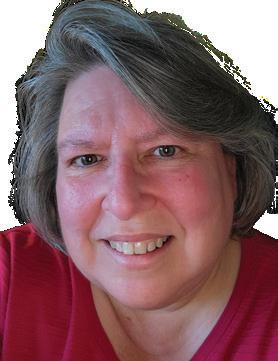
them with the opportunity to thrive.
“I feel like decorations really help lift spirits from the moment you walk in,” she said. “The goal is to create a positive atmosphere for our clients, so (that) they can really stay focused (on the good) and not dwell on the challenges that they’re experiencing.”
Along with bringing her passion towards helping people into action, Bisley also encourages and highlights the significance of volunteer work, especially within fighting the homelessness crisis.
“(There could) be one person that may have really made a difference (in their life),” she said. “The volunteer might not know that they were that one person, but they might have been the first person who really saw the client for a really long time, (helping them) start to see themselves as being worthy of doing something.”
an especially profound impact on unhoused youth, a demographic which often includes those who identify as LGBTQ+, teenage parents or children who are running away due to neglectful or unsafe dynamics at home.
Often, it is the oversimplified understanding of being “homeless” that hinders productive progress in the right direction, emphasizes Palo Alto Council Member Greg Tanaka. “If we dealt with each situation one-by-one and case-by-case, I think we’d get a lot more headway,” he said. itself, unfortunately, (homelessness assumes the root cause is simply a lack
In San Francisco, city leaders had the U.S. Supreme Court for months legal battles with the crisis. The Point-in-Time count by the Homelessness and Supportive Housing sheltered and unsheltered population from 7,754 to 8,323 people.
In September 2022, the Coalition alleging that San Francisco violated homeless encampments and homeless American Civil Liberties Union attorney John Do who is representing maintained that his side would move of the Grants Pass Case. He cited the Francisco to offer shelter before clearing “bagging and tagging” the belongings
“(The Supreme Court’s) shameful protection for unhoused people, but San Francisco, which has policies and to offer shelter before clearing encampments,” San Francisco has decided to take as the city is pressured to reduce homelessness. progressively more stringent with each affirmed by San Francisco Mayor Francisco Examiner reporters.
“We’re offering help, we’re offering of restrictions with the laws, and I think has really provided us with clarity that more aggressive with people who are she said.
Regional partnerships could be one crisis in the local area. Currently, some their resources, using a more human combat this increasingly nuanced social

For example, East Palo Alto Mayor Antonio López proposed a mutual “regional partnership” in August. This would include a collective fund for neighboring cities, including Palo Alto, to share resources for shelters, mental health services and permanent supportive housing. López plans to propose a city ordinance to remove East Palo Alto encampments in late September, and if the city proceeds, it would give people two warnings to clear out their belongings and move into a shelter. The city will not issue citations or relocate people who might refuse shelter, López said at an August press conference in East Palo Alto’s Martin Luther King Jr. Park.
“This will be done in order to leverage our resources collectively and minimize the migration of the house from jurisdiction to jurisdiction,” he said.
According to an East Palo Alto press release, the Palo Alto City Mayor Greer Stone supports this multi-city initiative and sees it as an ethical approach to people who reject services but need the assistance.
“Having a plan in place, where we have similar policies from city to
Further decisions on housing and homelessness are a key focus at all levels as the Bay Area enters the presidential, state and local elections.
For freshman Cordelia Hayes, interest in helping and humanizing the unhoused community extends beyond a state-level initiative. In recent months volunteering as a Student Community Liaison for LifeMoves, a local nonprofit, Hayes has facilitated meetings between schools, faith-based organizations and nonprofit services to discuss her idea of having a “definite of contact.” This may include a designated individual or team that oversees volunteers and their needs in order to combat the turnover and pause in service when students graduate and support staff leave.
A nationwide survey of homeless service workers by the Homelessness Research Institute identifies that 71% of the respondents experience high employee turnover in their organization. Additionally, 44% of them report that they are overwhelmingly impacted by low salaries and difficulties with paying for their housing.
“Creating a consistent point of contact (for the LifeMove’s office) is not the first thing that you picture when you think of charity work, but that it’s what I can do to help,” Hayes said. “Anything anyone can do to help has a massive impact.”
As the homelessness crisis intersects with changing policies, Hayes hopes that students continue educating themselves on the issue and understand that solving homelessness requires recognizing its proximity to our own lives.
“They’re just people,” she said. “People tend to think of homelessness as an outside experience, but more people than you would think are one hospital visit away, one layoff away from homelessness. So it’s an issue that’s closer to home than you could ever imagine, especially when you’re seeing it face-to-face.”

Source: gov.ca.gov
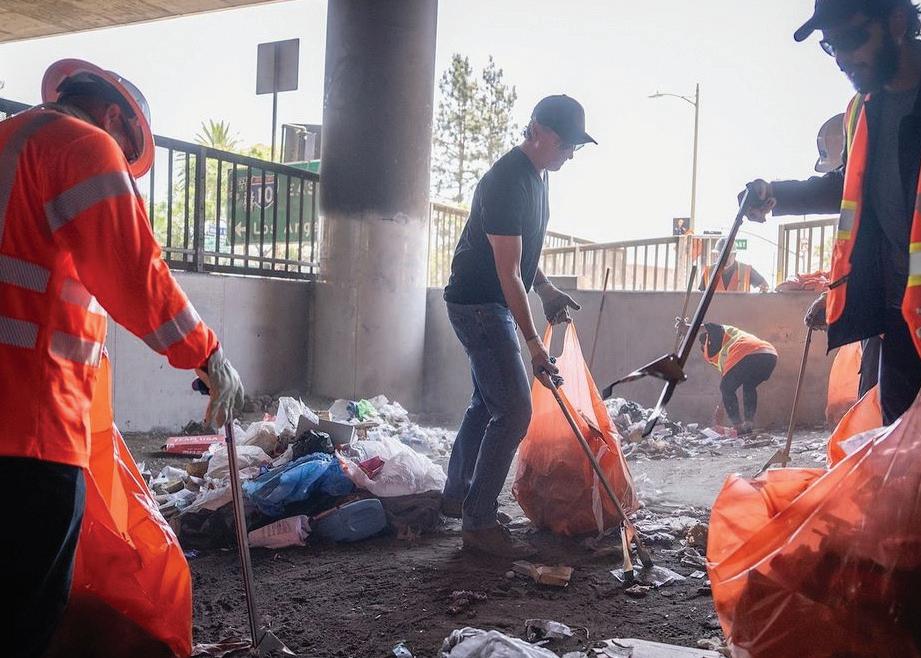
think said. “But I think because of the name (homelessness is) not properly dealt with and lack of a house.”
had been awaiting the 6-3 decision by months so they could address their own the San Francisco Department of Housing reports that the total combined population has increased by 7% since 2022
Coalition on Homelessness filed a lawsuit, violated the U.S. Constitution by clearing homeless people’s property.
Union of Northern California senior representing the Coalition on Homelessness, move forward no matter the outcome the city’s ordinance that requires San clearing an encampment, as well as belongings of the unhoused.
shameful decision guts a key civil rights it will not derail our lawsuit against and an ordinance requiring the city encampments,” he said in a statement. take the granted definitive authority homelessness. Penalties may become each instance in a breach of the law, London Breed, who spoke to San offering services, but we also have a lot think (the Supreme Court) decision that we will use in order to be a lot are choosing to stay on the streets,”
one way to respond to the homeless some Peninsula cities are combining human and coordinated approach to social issue.
city is going to make the most sense,” Stone told The Almanac online. “I think that East Palo Alto’s approach is the right one.”
In 2022, 274 people were homeless in Palo Alto, a slight decrease from the 313 in 2019, which is the most recent information in the Santa Clara County Point-in-Time Report on Homelessness.
For Tanaka, the reduction reflects the work of many advocacy groups. However, solutions will need to include a tougher stance in shifting the narratives of those who are unhoused.
“‘Homelessness is just a ‘catch-all’ phrase,” he said. “(The issue) has been tough to solve because we think it’s one issue: A lack of home. It’s a lot more complex with root causes including drug abuse, domestic abuse and youth running away.”
CEO of ConXion to Community Rose Amador, a local nonprofit providing job training, services and amenities to previously incarcerated or unhoused individuals and families in Santa Clara County, struck a similar tone. The double bind of transitioning the unhoused to longterm shelters often involve undermining a special connection that they’ve built with their encampment spaces and communities.
People tend to think of homelessness as an outside experience, but more people than you would think are one hospital visit away, one layoff away from homelessness. So it’s an issue that’s closer to home than you could ever imagine, especially when you’re seeing it face-to-face.”
Freshman Cordelia Hayes
“People need help,” she said. “They don’t need to be uprooted and moved from one place to another so often. They lose a lot of their belongings and pets. (The City of San Jose) is going to have sanctioned places where people can set up a tent, but a lot of people will still feel attached and familiar to their original area,” she said.
“We had several people from our Day Worker Center who actually secured low-income housing, where they had to pay some rent, after living in their cars and trucks,” she said. “However, there are others who don’t want change, and so they cannot get the social, economic and mental help they need.”

WeHOPE is a nonprofit organization that provides mobile services such as food, shelter, job training and life skills to the unhoused. Their job training consists of free certification courses to help the unemployed and teach about financial stability. They also launched a reentry program for formerly incarcerated individuals to supply jobs with livable wages.

Since 1972, Covenant House has targeted youth homelessness and trafficking by providing food, shelter and medical care. Their main focuses include public education, collaboration, prevention, job readiness and transitional housing. Students, along with other community members, can assist in this effort by participating in their “sleep out” — one night where citizens sleep outside in order to show solidarity for those experiencing homelessness.

In their mission statement, LifeMoves sets out to address homelessness by providing interim housing, supportive services and building collaborative partnerships. Based in Palo Alto, they plan several local opportunities for employment such as providing meals to LifeMoves shelters, organizing food and resource drives and supporting summer adventure camps for unhoused children.

This nonprofit women’s shelter located in Palo Alto has been providing temporary seasonal shelter since 2012. They aim to promote volunteer opportunities for community members, including students. These opportunities consist of volunteering at shelters, cooking dinners, washing laundry, planning and participating in special events. The board of directors is open to experienced community members who want to get more deeply involved.

While many forget about their childhood stuffed animals, sophomore Johnny Na’s stuffed bear is one of his most treasured possessions. Sitting near his bed, it is a nostalgic reminder of his childhood, something that feels almost as if it were from another life. The bear, sewn by his mom, represents everything he’s been through.
“She sewed my Korean first and last name onto the bottom of the foot,” Na said. “I think that it really holds a big piece of my heart, because it shows how much dedication she put into it.”
However, the stuffed animal bear’s significance is more than just a token of a mother’s love for her son. It also brings Na back to his childhood, the experience he and his family had while moving back and forth across the world and the time he spent with his old friends.
“When I look at it, it reminds me a lot of my childhood,” Na said. “It reminds me of all the old times,
all the old friends I had and all the places I moved to and came back from.”
Na says that each move to a new city felt like leaving a part of himself behind. Having a memento to bring along made a big difference and gave him something to hold onto through trying times and big changes. For Na, his bear provided him that comfort as he
keep it with me because it’s like a good luck charm,”
Na said. “It was my mom’s first gift to me.”


Avocados, ice, milk and condensed milk — Senior Kean Tong throws these ingredients into a blender, recreating her favorite childhood delicacy: an avocado smoothie.

To many, a smoothie may be a
beverage to cool them down on a hot summer day, but to Tong, it’s a diary page that has come to life. The smoothie captures the essence of her childhood, and it’s so much more than an avocado milkshake.

‘Why would you blend avocados in my smoothie?’” she said. “It really pissed me off that I had to taste avocados in my smoothie all the time.”
Her changed attitude towards this childhood staple inspired her to actively seek it out and eventually create different versions of it to reminisce about her younger self.

“I usually made it with my mom because, when I was little, I always wanted boba, and my mom (would say) ‘No, you can’t have boba every single day,’” she said. “So then she started making these smoothies with avocados that were more healthy.”
Tong would enjoy the smoothie year round — whether it was during the summertime with extra ice or during the cold winter months at family events.
“It’s technically a Vietnamese dessert, so I’ve brought it to potlucks and still make it often,” she said.
Despite her love for the drink now, there was a point in time where Tong disliked it because it wasn’t her average fruit smoothie and it differed in taste.
“I remember hating it at first because I thought,
Naomi Wang
Looking at a glossy photo of her younger self holding an icy, pale yellow drink, junior Kristina Kibardina is transported back to her summer vacation in the Dominican Republic, reliving the contrasting emotions of joy from sipping a refreshing piña colada mixed with the frustration of an unexpected health incident.
“I have this photo of me before I got really, really sick,” Kibardina said. “I got some virus that ruined almost half my trip. That was a really memorable vacation.”
This photo lives in Kibardina’s memory box, which is the white packaging her computer came in. Despite its unassuming exterior, the box contains a variety of colorful photos, souvenirs and letters she has been keeping since elementary school.
Some items, such as homecoming polaroids and seashells from Hawaii, help Kibardina remember fun memories, while others, like her first paycheck and graduation certificate, mark important milestones.
“I don’t look at them often but, whenever I feel like reminiscing or reflecting on past experiences, it’s nice to have a physical (collection of objects) that I can
“There was a long period of time when I didn’t have it, and then I had it again, and it was so nostalgic for me. So now I really like it,” Tong said. “Before, I didn’t actively want to drink an avocado smoothie, but now if I see somewhere that is selling it, I always have to try it.”
—Written by Yael Gottesman
growing her collection and recommends that others create their own as well.
“I really want to keep my memory box for as long as possible, just to see my life throughout the years,” she said. “I want to keep adding to it so I can come back and reflect on my past to see how much I have grown.”




From lying in the afternoon sun to laughing with friends, sophomore Katherine Wu’s childhood has always been highlighted with splashes of color. The different flavors and sticky sweetness of Otter Pops, her favorite childhood treat, hold a special corner of nostalgia in her life.
“(I remember) hot summer days with my best friend, David,” Wu said. “(We’d) play basketball and hang out in my backyard driveway. My favorite (flavor) was blue raspberry (and his was) watermelon.”
While Otter Pops may be familiar to many, Wu, who grew up in Massachusetts, knew them as “Freeze Pops.”
While she doesn’t necessarily miss their artificial nature, Wu recalls the atmosphere of peacefulness she associated with them.
“I don’t miss (eating) the snack but I miss the
feeling of hanging out with my friends and just chilling all day,” Wu said.
Pre-COVID-19 memories feel far away, and Wu hasn’t seen her friends from Massachusetts or eaten an Otter Pop since the end of fifth grade. As the school year progresses, she reflects on what those moments meant to her and how she would feel enjoying her childhood treat again.
“I will probably just remember my old friends from Massachusetts,” Wu said. “And how much fun I had with them during (those) summers.”
—Written by Vanisha Vig
For many, sentimental objects include a diary, old pictures or artwork. But for senior Dennis Tierney, it’s a small, simple piece of jewelry that holds layers of cultural significance, personal memory and tradition.

This necklace consists of a light knitted black string adorned with an evil-eye charm in the middle, a symbol deeply rooted in Turkish culture.
It’s a symbol of protection that represents the belief that a jealous or
envious look can cause misfortune.
“I’ve had this since I was 10," he said. (Due to fraying), it keeps getting shorter and shorter, but it keeps the evil spirits away.”
Tierney, who speaks fluent Turkish, flies to his home country, Turkey, every year. To him, the necklace isn’t just a souvenir, it’s a meaningful artifact that represents more than just the time he spent shopping with his mom to get the gift in Aktur, Turkey — a small vacation town.
“(The evil eye) is a huge part of Turkish culture and the guy who made this died as well, so it’s kind of a memory of him as well,” Tierney said. “He was the guy that would make necklaces there, so he was a big It’s one of the last ones he made.”

Although he isn’t religious, Tierney believes


in the importance of honoring a piece of cultural heritage that resonates with many in Turkey, which is why he chooses to wear the necklace. While he was initially attracted to the appearance of the necklace, his appreciation changed as he understood its significance as a blend of culture, memory and personal narrative. Tierney wears his necklace proudly every day, reminding him of all his memories and connections to his culture.
“I don’t really believe in a spirit that actually keeps bad spirits away,” Tierney said. “But I like the cultural significance of it. I like the idea and it’s something that a lot of people in Turkey believe in and use.”

Five bowls lined up neatly on the dining table alongside porcelain spoons — each filled with steaming chicken soup and glistening wontons floating on the surface — greeted junior Xiwen Liang as she entered her grandparents’ house. After a 15 hour flight, the savory smell wafting towards her brought years of memories and a smile to Liang’s face.
This summer, five years since moving from China to the United States, Liang returned to her home country where she visited relatives and had the opportunity to eat her grandpa’s homemade crab wontons. Though wontons are a common food in China, especially in Suzhou where her grandparents live, the tomalley filling — yellow crab innards, considered a delicacy in China — and the effort required to make them stands out.
“It takes a long time to prepare, and you can feel the love they put into it,” she said. “They have to hand pick out all the tomalley from the crab meat without eating it, which is hard when it’s right in front of you.”
Even in Liang’s younger years, this dish was a rare treat that she and her sister only ate once a year. Each summer, when the family traveled to her grandparents house, they had the tradition of eating crab wontons as their first meal.
“It’s special because it’s my grandpa’s own recipe, and I have been eating them since childhood,” she said. “Now, it makes me feel nostalgic when I get to eat it.”
Missing the taste of authentic Chinese food and inspired after years of watching her grandpa make the wontons, Liang and her family started making their own wontons from scratch.
“We start with flour to make the dumpling wrappers, and we even bought a pasta machine to roll out the dough,” she said. “We don’t have good crabs over here though, so we can’t make the special version, but it still reminds me of family.”
—Written by Ya-An Xue
—Written by Yael Gottesman


Senior Rhianna Middleton stared at her phone, torn. The screen read 7:30 p.m., the time her shift at Läderach should end. However, the sales goal her manager had set for the day was far from met. Middleton felt obligated to stay later to make more sales, despite having a load of unfinished schoolwork waiting for her at home. The dilemma between either prioritizing work or prioritizing school left Middleton overwhelmed, as these responsibilities both weighed heavily in importance.
For Middleton, the stressful scenario of trying to maintain balance in both her academic and work life is a common problem during the week. Although she understands the requirements of being a good student, working at the Swiss chocolatier Läderach in Stanford Shopping Center is crucial for supporting her future goals.
“I started working to save for an apartment for when I go to college,” Middleton said. “I also need money for college tuition and future living expenses. Right now, (it) is a very important period of time for me to make and save money.”
Middleton normally goes into work immediately after school using either the school bus or the city’s transportation system, Palo Alto Link. She clocks in at 4:30 p.m. on Mondays, Wednesdays and Friday, and 1:30 p.m. on Tuesdays and Thursdays, leaving school earlier thanks to her third and fourth period preps. She is scheduled to clock out of Läderach at 7:30 p.m. but is typically held back later until around 8 p.m. or 9 p.m. on the holidays due to the store’s financial goals.
“We have a money goal for every single day, which is basically the amount of sales we have to make, and we have to make or exceed that,” Middleton said. “It gets overwhelming when we don’t make our goal. When we don’t reach our goal, we’ll stay open later, and obviously that interferes with my schedule because my schoolwork gets pushed back.”
Although Middleton’s responsibilities as an employee can sometimes overlap with her ability to manage and submit school assignments in a timely matter, she is still able to keep her grades from being affected.
“Work doesn’t really affect my grades at school,” she said. “I’m really good at communicating with my teachers about late assignments or missing work and how to make it up. If I need to do an assignment or if I have a friend in that class, I’ll just talk to them about the assignment, so I’ll get it done regardless.”
However, although Middleton is good at expressing her situation in a timely manner, she feels teachers aren’t always understanding of her work responsibilities.
Work doesn’t really affect my grades at school. I’m really good at communicating with my teachers about late assignments or missing work and how to make it up.
“There’s been times when I’ve talked to teachers about how my work at Läderach has made it difficult to focus on school and complete schoolwork, and they’ve just said to me, ‘Well, you’re not sick, and it’s not your mental health, so you have to figure that out.’”
A resource Middleton thinks would offer her more support as a student worker at Gunn would be an alternative wellness dedicated to catching up on schoolwork. It would be a similar environment to wellness, somewhere teachers could send students so that they could leave class and work on other assignments.
On the flip side, Middleton feels that Läderach is supportive of her being a student as well as an employee and is lenient when she’s overwhelmed.



“My manager is really big on the idea that school comes first,” Middleton said. “She obviously wants the store to be up there as well, but she’ll tell me, ‘If you have anything big coming up, just let me know two weeks ahead,’ which is not normally a problem because I know when tests and assignments are happening in school.”
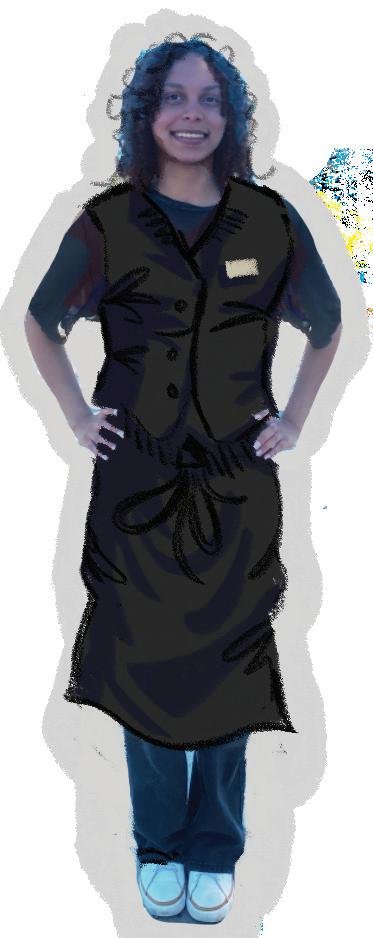
A way that Läderach supports her being a student is offering her one day off
Work is a staple in my life to secure my future goals and help better me as a person. Later I will look back at this stressful time and feel gratitude.
Senior Rhianna Middleton
“I always have one day off of work,” Middleton said. “I normally choose Tuesdays or Thursdays, if I’m able to, as my day off because I have a fourth and third period prep. Then that gives me from twelve to the entire night to do all my homework.”
Middleton’s work environment is overall friendly and welcoming. She describes a normal shift as mostly customer service and working alongside other employees. When she clocks in, her manager will give her a debrief on the projects that need to be completed. Middleton usually takes the more complicated projects as a senior employee and later on helps other co-workers complete their tasks.
“Projects are usually tying ribbons on the chocolates or refilling giant slabs of chocolates by the display window,” Middleton said. “There’s also refilling our pralines and truffles, doing extra deep cleaning and things like that.”
However, customers are top priority to reach the end-of-day goal and create profit for the store. When customers come in, Middleton and the rest of the employees shift their focus to them.
“Whenever a customer comes in, we pay full attention to the customer,” she said. “It’s fully (about) customer service and getting customers inside the store with tactics such as sampling.” Being good at communicating with customers is important to being able to reach the store’s daily financial goal. Middleton finds working in sales easy for her because of her past experience working with kids. Before she started working at Läderach last October, Middleton used to babysit and help out at a local day care center. The skills she acquired while working with kids is also applicable to working in
“Working with kids and being in sales (is) almost the same,” she said. “A lot of customers are like kids. I’m just promoting and selling something and trying to convince a customer to buy it, similarly with convincing a kid to eat their food or share their toys. I feel like those are very similar in my brain.”
Although creating an equal balance between the responsibilities as a Läderach employee and senior can be difficult at times, Middleton loves and appreciates
“I would say work definitely does interfere with school, but I really like my job,” she said. “It’s not like I don’t want to be at work. Work is a staple in my life to secure my future goals and help better me as a person. I think later I will look back at this stressful time and feel gratitude and be proud of



Gunn’s founding in 1964 marked the beginning of the tackle football team, recently accompanied by the girls flag football program, starting this year.
Tackle football and flag football share many basic similarities — scoring, defensive positioning, offensive roles and defensive roles — but the key difference lies in the method of stopping the ball carrier. In tackle football, full contact is required to physically tackle opponents to the ground to end a play. In contrast, flag football is a non-contact sport where players pull a flag attached to the ball carrier’s waist in order to stop the play. Although the rules and techniques for blocking in the two sports differ significantly, they both require players to share a similar mindset in order to succeed on the field.
According to former tackle football coach and current girls flag football coach Brian McCormick, the lack of contact in flag football can make some aspects of the sport significantly more difficult.
“In tackle football, (physical contact) is an advantage in a lot of ways,” he said. “They can get their hands on you, they can push you out of your patterns and they can slow you down at the line of scrimmage. (In flag football), we just can’t touch (the opponents), so we’ve got to be really quick and try to understand what route they’re running and get on their hip without any
calls for adjustments in playing strategy.
“Sometimes there is a little more strategy,” McCormick said. “Because, from a passing perspective, I’ve got this big field, I have more time (and) the quarterback has more time. I’ve got a huge field to cover with seven people. It’s just a much different animal.”
On the other hand, the element of tackling in traditional foot ball can be very difficult to master and execute, both physically and mentally. Tackle foot ball coach Dethrick Slo cum emphasizes the ex treme physicality of tackle football.
“You can’t be afraid of contact,” he said. “And in my opinion, you have to have a lot of heart. When we say heart, (we mean that) you can’t be passive out there on the field. You have to be aggressive.”
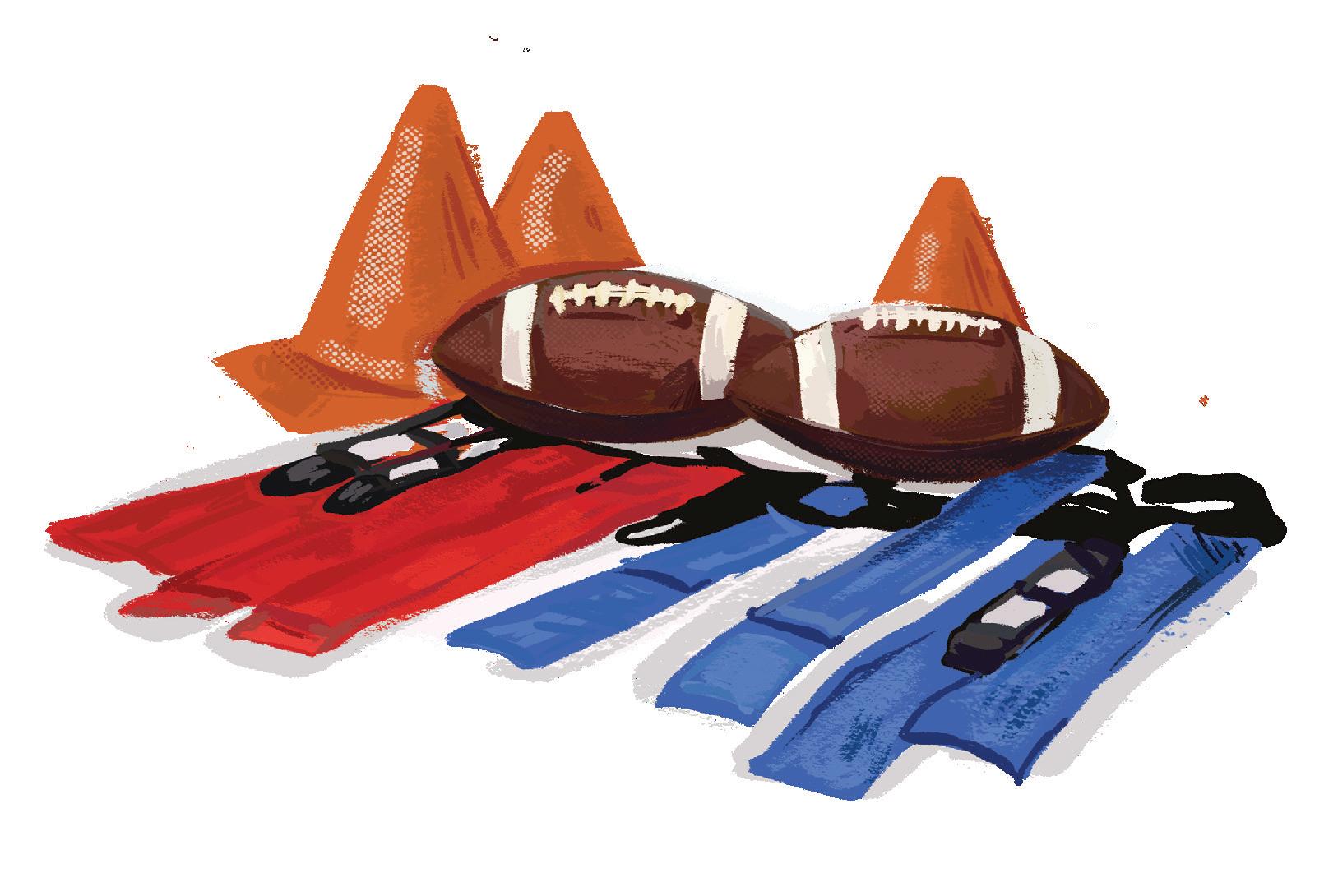
For girls flag football player senior Audrey Kaplan, the large amount of contact in tackle football deterred her from trying the sport. Although she had grown up watching and admiring the sport, she did not have the opportunity to begin playing herself until flag football was introduced as a school sport.

“A big part of (tackle football) is physically using your bodies to push another person over,” she said. “And for me, that’s just not something I would ever consider doing. Obviously, you can get hurt by doing any sport, but the risk of injury is much higher when you’re in a contact sport.”
Slocum’s team is currently trying to improve on play execution, tackling and communication. For him, the most important
into their sport.
“Coming out here, listening to your coach and then applying what your coach is telling you on the football field (is important),” he said. “We also want guys to come out here and compete against each other because, if they come out and don’t compete against each other, they don’t get better.”
According to tackle football player senior Tuuta Fisiiahi, the most glaring similarity between the two types of football is the need for a good attitude when stepping on the field.
“Mentally and physically, you have to have a good work ethic,” Fisiiahi said. “You have to come in (with the) mentality of wanting a winning season, not just coming here to stay on the field just because you’re playing football.”
Written by Kaylee Cheng and Anne Dong
Recently, with the growth and acceleration in developing data analysis technologies, predictive analytics has grown to be more effective than ever. Getting statistics from different observations — which was once difficult to obtain accurately due to a degree of human error — has now been expanded and refined with the help of advancing technologies. This has caused a surge in the use of projections and other statistics models in different business sectors, including sports.
This increased reliance on data science and projections has been seen before in the early 2000s with the “Moneyball” era in sports. This term refers to a time period after the Oakland Athletics built an extremely successful baseball team using statistics and many other Major League Baseball teams followed suit. According to AP Statistics teacher Rachel Congress, however, the shift to relying on data science inspired by the Oakland Athletics eventually tapered off, as qualitative data collected by the human mind took the forefront again.
“With (this) era of baseball, the pendulum swung in the direction of ‘data is the way to go,’” Congress said. “But then the pendulum started to swing the other way in that there are things that humans see that the data doesn’t pick up.”
Currently, the increased frequency of statistics usage can be clearly seen in sports management. According
to Congress, new technologies provide the opportunity to analyze a player more fully by examining even more data than before, aiding teams in crucial decision-making processes.
“For example, (in) football, they’re starting to put sensors inside the football uniforms that track how fast the players are running and what path on the field they’re taking, and that is so groundbreaking,” Congress said. “You can do so much more when you’re not just viewing players from above, but when you’re actually getting that data from down on the field. That, in turn, is being used more effectively to train players, trade players and make draft picks.”
With the understanding that society is shifting towards a focus on the use of data science, lawmakers are also finding it useful in decision-making, as projections can predict the impact of actions by the government. However, according to economics teacher Jeff Patrick, there are some drawbacks to the use of these projections in policymaking when the decision-makers put their own needs over the people’s.
“I think the issue occurs when people have an idea about a policy that they would like to see put in place, (but) they neglect the economic impact of it for either individual or group gains versus what’s better off for the entire society,” Patrick said.
Such a shift to using statistics also creates a newfound use for collected data. According to vice president of the Data Science Club junior Jolie Zhou, the use of past data becomes increasingly important to use as a tool to analyze trends and apply them to the status quo. The findings can then be used as a boon for workers and the world as a whole.
“A lot of the data that we’ve gotten from the past is meant to help us navigate the future, so having predictive analytics will help us do that better and make sure that we have a good analysis of what could happen (in the future),” Zhou said. “For example, in the healthcare industry, because of predictive analytics, we’ve gotten a lot more data on what could happen, and it’s helped a lot with preventative care.”
Due to the widespread use of statistics and quantitative analysis, it is important for statistics to further enhance society. According to Patrick, it is also necessary for the people to properly understand the statistical results that they see.
“Hopefully, (the models) get more accurate and become more widespread and understood by people so that we are looking at the same thing and contextualizing it the same way,” Patrick said.
Written by Yu-Ming Liu


DoorDashing, while convenient for students, is often quite bothersome for teachers. Students will find excuses to leave class without realizing the potential safety concerns and long-term impacts associated with it. To maintain a focused learning environment, students must put in the effort to be present during lessons. If they aren’t, they risk losing class time, falling behind in content and causing distractions in the classroom environment.
Math and computer science teacher Savannah McDonnell has seen this issue in her class. She is concerned that more and more students are lying and cutting class in order to retrieve food, effectively distracting other students in the process.
“When (DoorDash) is in the classroom and a student needs to leave class, the food attracts attention,”
McDonnell said. “I definitely think it is a problem. (DoorDashing) has definitely increased post-pandemic.”
McDonnell notes that if students constantly leave her class to pick up food, there will be repercussions.
However, unlike McDonnell, senior Aarya Bhushan finds DoorDash a useful tool because there are no walkable restaurants nearby.
“There’s not really anywhere (students) can go a without
a car,” she said. “School lunch is not enough, so they will have to DoorDash.”
Despite DoorDash being a straightforward alternative for students, Bhushan sympathizes with teachers who are inconvenienced by DoorDashing.
“I think (students) are more inclined to DoorDash because it’s convenient, but I understand why teachers get annoyed,” she said. “There is not a proper way to go pick up your DoorDash and there isn’t an understanding if it’s allowed or not.”
Freshman Shaoie Chan Chordia echoes Bhushan’s sentiment, understanding that it can be both disruptive and beneficial for certain students.
“I think it is a little disruptive when someone is actively planning their DoorDash order during class, but I (don’t) think of (it as a) major disruption,” Chordia said. “Maybe students don’t have the time or knowledge to make their own lunch, or they prefer prepared food — it’s faster and considering grocery prices, sometimes it’s cheaper.”
In addition to rising concern from teachers, according to Assistant Principal of Safety Dr. Mycal Hixon, administrators are also concerned about students’ safety on the Gunn campus.
DoorDashing can pose a number of campus security concerns. The process of purchasing food through an online thirdparty retailer relies on unauthorized adults entering campus to drop off the food. The issue with this is that staff
doesn’t know the delivery person and whether or not they could be a potential threat.
“(Administrators) have to continue to make sure that it is safe,” Hixon said. “There is a drop-off station at the main office, but it doesn’t always make it to the main office. Some of the Dashers are constantly calling students and students are leaving class, losing class time trying to pick it up.”
Hixon proposed a possible system to relieve some of the staff’s safety concerns.
“Something we could do is placing signs throughout the parking lot, clearly saying that (DoorDash drivers) need to check into the main office,” Hixon said. “(Campus supervisors) should be more vigilant about this and make sure (unauthorized) people aren’t walking around campus.”
Ultimately, DoorDashing — a seemingly harmless way of obtaining food for students — has the unintended effect of promoting the act of cutting class and increasing the risk of safety concerns.
“It can be a great tool,” Hixon said. “We just have to continue to make sure everything is safe.”
Peaceful, down to earth, authentic and distinctive. These are all ways to describe the coffee shop hidden on California Avenue: Backyard Brew. From the art-covered entrance alley to the customer-made notes covering the walls, Backyard Brew is enticing and unlike any other coffee shop around. Along with the serene outdoor vibe, the pastries and drinks are both excellent and unique, making it a great go-to spot for a nice study session or for a releasing diversion from the demands of everyday life. The menu ranges from numerous different flavors of lattes, to a large variety of flavorful pastries. This local coffee shop is enjoyable and versatile.
Coupa Café is an eccentric family-run coffee shop with two different locations around downtown Palo Alto. It has a colorful, cozy space characterized by welcoming furniture and a snug fireplace with an airy, lush outdoor seating area. These aspects make this café both a popular sit-down and grab-and-go coffee shop.
The beloved small chain is a perfect place to study, have a meeting or catch up with friends.
The menu sits on the pricier side — $10 to $20 for food and $4 to $8 for drinks — and the actual coffee is not high quality. However, the pastries and food menu are inviting and the location and setting are very delightful. This local coffee shop is cozy and comforting.
The outdoors, Italian-style seating of the University Avenue café, Café Venetia, resembles a beautiful scene in Venice, Italy. When sitting amongst the charming red tables, eating a delicious pastry and sipping coffee out of a small mug, one could transport themselves from California to the striking streets of Italy. In addition to its illustrious setting, it also has later open hours, giving it, unlike most other coffee shops in the area, the perk of extended hours. Their coffee is one of the best in town, and the rich hot chocolate is unbeatable. They also offer a wide variety of delicious pastries and chocolates, which — when paired with the drinks and the café itself — are worth the price.




“The __ on the cake”
__ Band from “Star Wars”
1. Tuba sound
2. Apprentice
3. Phone insertion
4. Singer Lovato
5. Short-legged dog
6. “What?”
7. Puerto Rico’s __ Observatory, home to the Western Hemisphere’s largest radio telescope
8. Asimov and Newton
9. Type of D.A.
10. Half a Hawaiian fish
11. Russian duke known as “the Great”
12. “Rico Suave” rapper
13. Noah’s boat
18. “Star Trek” rank, for short 19. Double-helix molecule
22. Play a part
24. Zap
#5
2023 best picture winner, for
Charge for 35 down
U.S. Army award above silver
Wisconsin college or its city
Opposite over hypotenuse
Deep-fried shrimp
Whacks, as a fly 58. SEE STICKER #6 61. Pulls out all the __
March Madness org.
63. To __ their own
64. __ good example
65. Microbe
66. Electro ending, like Gatorade
26. Barbie’s boyfriend
28. Big name in aluminum foil
30. __ California, Mexico
31. Wizard’s walking stick
33. Designer Gucci
34. Take to court
35. Hailed vehicle
37. Cowboys quarterback Tony
38. Proof letters
39. Paraphrase
40. King Arthur’s realm
41. New __, footwear brand
42. Berkeley and Oakland region
43. Split into thirds
44. Perfect __, in gymnastics
46. Buzzed again
49. Hot dog holder
For “STICKER” clues, use the name of the numbered stickers in the “Guess the Teachers” game below!


“The koala is from my daughter, who’s six, and the small (stickers) are all hers. She put those on there.”



“This sticker is of my cats, Kishi and Bashi. These stickers are also sometimes given out as prizes in my class.”
50. “It Had to Be You” composer Jones 51. A fifth of 44 down 54. Sports honorees, briefly 55. The leaning tower of __ 57. Cain’s twin 58. __ profile, FAFSA alternative
59. To give, in Spanish 60. “Murder __ wrote”
—Crossword by Violet


“(My) oldest sticker is probably the blood donation sticker. (It’s from) when the blood drive comes to campus, and I go donate blood.”

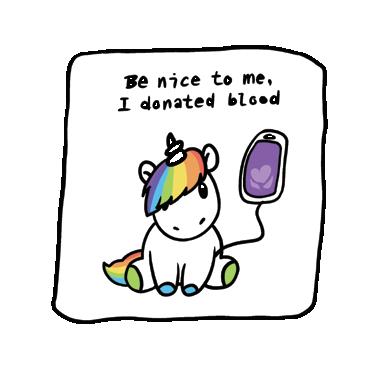

“(My) newest sticker (is) Project Minotaur. (It) was the best escape room I’ve ever been to in my entire life. I used to work in an escape room, so I’m a big fan of them. ”




“This is a sticker from (when I was in) high school. Great Bear Coffee is a coffee place in Los Gatos. We used to go there all the time.”

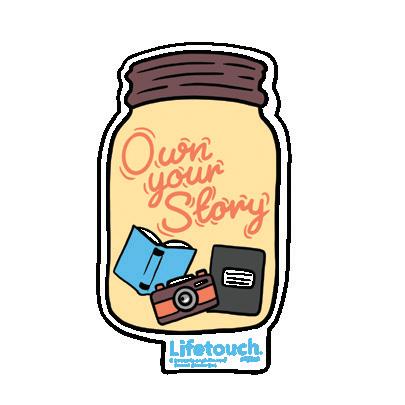
Want to write a mini crossword to be published in The Oracle? Send us your 5x5 mini crossword puzzle to gunnoracle@gmail.com by Nov. 8 to be considered for the December issue!

When sophomore Isabella Cruz was 11 years old, she attended Fiesta de la Caza Azul for the first time. There, she felt pure joy and excitement being surrounded by people who were similar to her. Every year, Cruz and her family attend this celebration where people from around the Bay Area come together and dress up in Frida Kahlo makeup and clothing.
Being half Guatemalan and half Nicaraguan, Cruz has found a beautiful intersection between the two countries by attending festivals which celebrate food, music and culture. She specifically enjoys events dedicated to Mexican painter Frida Kahlo, an inspirational figure to the Hispanic community. Many of the Kahlo paintings adorning Cruz's
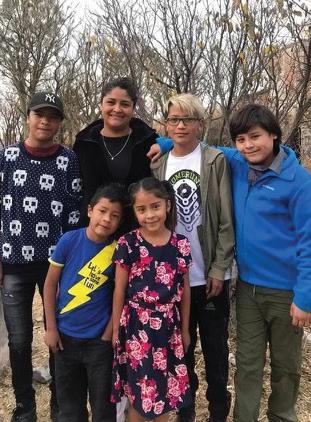
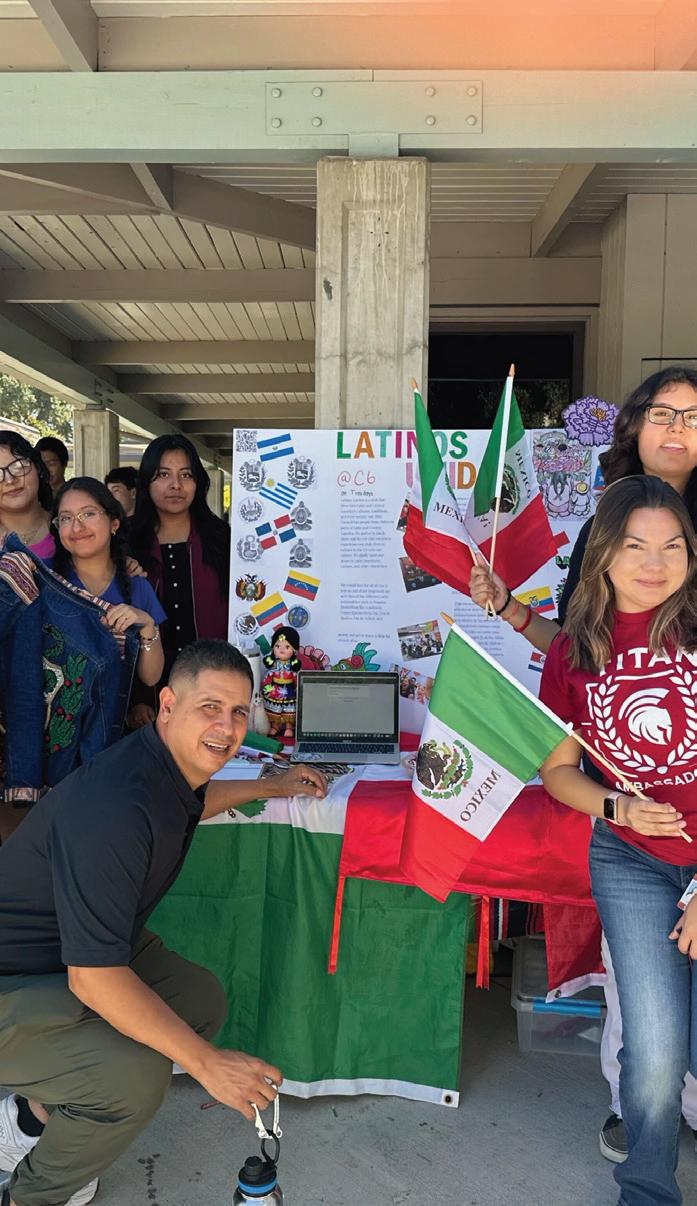
home speak to her, strengthening ties with her heritage and inspiring Cruz to create art herself.
“I had a photoshoot where I dressed up as Frida Kahlo,” she said. “In July, I was able to be a model for another Frida Kahlo look.”
Even though the Gunn community is welcoming of other cultures, Cruz still finds it difficult to find peers with similar cultural backgrounds. Some of them were raised the same way as her and are easy to bond with, but Cruz still sometimes feels out of place because of specific cultural differences.
“Most of my friends are from Mexico, or they’re Salvadorian so I don’t really know anyone who’s Guatemalan and Nicaraguan,” she said.
With an explosion of color, the piñata breaks and the festivities begin. Sophomore Santiago Rosales enjoys connecting with his culture through such celebrations, especially since he moved from Mexico to the United States when he was six. Later, he moved to Palo Alto and noticed many cultural differences, such as the absence of bustling corner stores and day-to-day interactions.
“You have to let go of a lot of things, (such as) the culture you experience in Mexico,” he said. “It’s a big change.”
In Mexico, one thing Rosales looked forward to was “Posada,” which is a religious festival full of food, candles and piñatas. People on a street would gather together with an abundance of home-cooked food and hand it out to the less fortunate. The celebration often involves a candle ceremony and a reanactment of the Nativity — the birth
of Christ.
“The main thing about the Posada is that a lot of people gather around to help and give to those who don’t really have enough, or who are just struggling,” he said.
To Rosales, food is an integral part of both Posada and other cultural celebrations. The crispy fried chicharrón and flavourful meat filling in tamales are comforts he looks forward to. However, he sees a contrast in people’s familiarity towards the festivals based on how connected they are to their culture.
Despite being in the U.S. for many years, Rosales has always felt in touch with the Spanish language. It has even helped him make friends when he first moved.
“Ever since I moved to the U.S., I've been looking for people who speak Spanish,” Rosales said. “I also speak
Additionally, it is difficult for Cruz to find peers who appreciate Frida Kahlo as much as she does. Most people, she feels, don’t know that Guatemalan and Nicaraguan cultures revolve around art. Cruz models to show the community what her culture is really about.
“That’s why I’ve gotten into modeling because, when people see my photos, I want them to see someone with Mayan and Nicaraguan features,” she said. “It’s very important to me to make sure that (my heritage) and (the beauty of my culture) is shown in my photos.”
it at home with my dad and mom, so I've never really felt like I'm losing the language, because I try to find ways so I don't forget things.”
Rosales cherishes activities that help him keep in touch with his culture and remind him of his time in Mexico. While it may be difficult, he encourages others to embrace whatever cultural connections come their way.
“Exploring different people’s culture and even just explaining your own, is kind of the biggest thing,” he said.
At the beginning of every September, Gunn’s Safety and Family Specialist Joey Ordonez looks forward to the grand and lively festivities of Mexican Independence Day. Filled with many delicious foods, such as birria tacos and traditional prayers spoken at the start of the celebration, Hispanic Heritage Month is a special time for Ordonez and his family.
“A lot of people usually say (it is) Cinco de Mayo, but the real date for Mexican Independence Day is September 16,” he said. “We (hold) a fiesta, very similar to what we do here for Fourth of July, (and we) get together with family and friends. Usually, a lot of our families get together. We barbecue, hang out and dance to music.”
Since moving to the United States, the celebration has taken on a different form: smaller gatherings in parks or public spaces. Despite the change, the spirit remains the same.
Ordonez also carries the importance of Hispanic Heritage Month to Gunn through the Latinos Unidos club, which consists of students from all over Latin America including El Salvador, Guatemala and Belize.

“This year, we’re actually going to do a potluck just for our club,” Ordonez said. “The
(students) wear their soccer shirts or their bandanas to show that it's independence day. We also want to celebrate, not only Mexico, but also that it's Hispanic (Heritage) month as well.”
Looking to the future, Ordonez envisions Hispanic Heritage Month growing into a major celebration on campus. He aspires to see it gain the same prominence other cultural events have.
“I'm hoping it will look like Oktoberfest,” Ordonez said. “I think we would do a really good job of promoting and organizing the events to celebrate all of our culture from down south.”
—Written by Yael Gottesman


